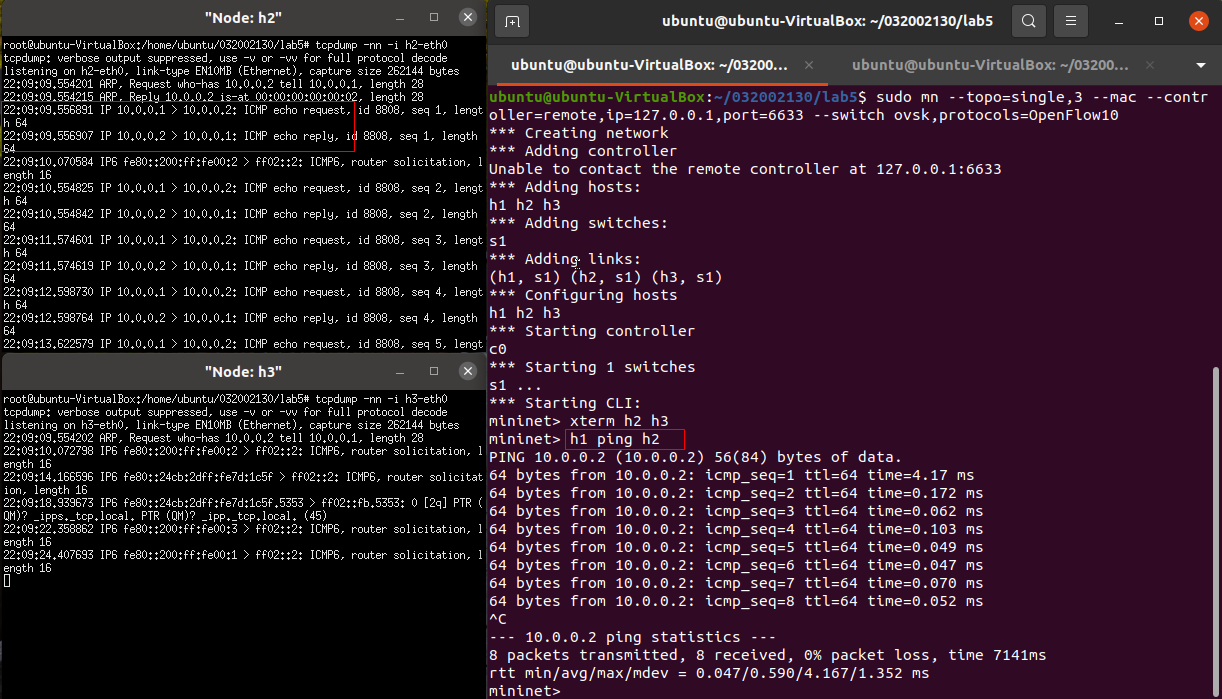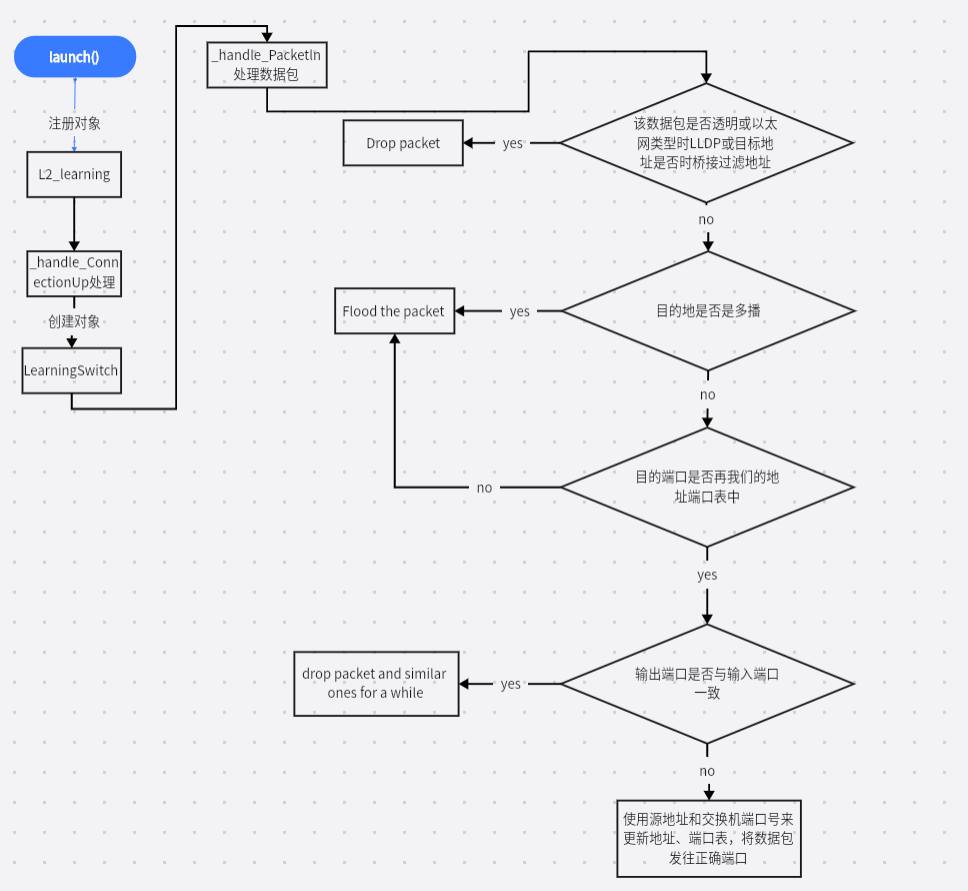实验5:开源控制器实践——POX
基础要求
tcpdump 验证Hub模块
h1 ping h2,h3主机同样收到报文
h1 ping h2的tcpdump抓包结果截图

h1 ping h3的tcpdump抓包结果截图

tcpdump 验证Switch模块
h1 ping h2,h3只有被ping的对象收到报文
h1 ping h2的tcpdump抓包结果截图

h1 ping h3的tcpdump抓包结果截图

L2_learning模块代码流程图

进阶要求
1.重新搭建(一)的拓扑,此时交换机内无流表规则,拓扑内主机互不相通;编写Python程序自定义一个POX模块SendFlowInSingle3,并且将拓扑连接至SendFlowInSingle3(默认端口6633),实现向s1发送流表规则使得所有主机两两互通。

代码
from pox.core import core
import pox.openflow.libopenflow_01 as of
class SendFlowInSingle3(object):
def __init__(self):
core.openflow.addListeners(self)
def _handle_ConnectionUp(self, event):
msg = of.ofp_flow_mod() # 使用ofp_flow_mod()方法向交换机下发流表
msg.priority = 1
msg.match.in_port = 1 # 使数据包进入端口1
msg.actions.append(of.ofp_action_output(port=2)) # 从端口2转发出去
msg.actions.append(of.ofp_action_output(port=3)) # 从端口3转发出去
event.connection.send(msg)
msg = of.ofp_flow_mod() # 使用ofp_flow_mod()方法向交换机下发流表
msg.priority = 1
msg.match.in_port = 2 # 使数据包进入端口2
msg.actions.append(of.ofp_action_output(port=1)) # 从端口1转发出去
msg.actions.append(of.ofp_action_output(port=3)) # 从端口3转发出去
event.connection.send(msg)
msg = of.ofp_flow_mod() # 使用ofp_flow_mod()方法向交换机下发流表
msg.priority = 1
msg.match.in_port = 3 # 使数据包进入端口3
msg.actions.append(of.ofp_action_output(port=1)) # 从端口1转发出去
msg.actions.append(of.ofp_action_output(port=2)) # 从端口2转发出去
event.connection.send(msg)
def launch():
core.registerNew(SendFlowInSingle3)
运行结果


2.基于进阶1的代码,完成ODL实验的硬超时功能。
代码
from pox.core import core
import pox.openflow.libopenflow_01 as of
class SendPoxHardTimeOut(object):
def __init__(self):
core.openflow.addListeners(self)
def _handle_ConnectionUp(self, event):
msg = of.ofp_flow_mod()
msg.priority = 2
msg.match.in_port = 1
msg.hard_timeout = 10
event.connection.send(msg)
msg = of.ofp_flow_mod()
msg.priority = 1
msg.match.in_port = 1
msg.actions.append(of.ofp_action_output(port=2))
msg.actions.append(of.ofp_action_output(port=3))
event.connection.send(msg)
msg = of.ofp_flow_mod()
msg.priority = 2
msg.match.in_port = 2
msg.hard_timeout = 10
event.connection.send(msg)
msg = of.ofp_flow_mod()
msg.priority = 1
msg.match.in_port = 2
msg.actions.append(of.ofp_action_output(port=1))
msg.actions.append(of.ofp_action_output(port=3))
event.connection.send(msg)
msg = of.ofp_flow_mod()
msg.priority = 2
msg.match.in_port = 3
msg.hard_timeout = 10
event.connection.send(msg)
msg = of.ofp_flow_mod()
msg.priority = 1
msg.match.in_port = 3
msg.actions.append(of.ofp_action_output(port=1))
msg.actions.append(of.ofp_action_output(port=2))
event.connection.send(msg)
def launch():
core.registerNew(SendPoxHardTimeOut)
运行结果

个人总结
个人感想
本次实验第一次接触 POX 开源控制器,了解了其工作原理、常用组件,并验证了 POX 的forwarding.hub 和 forwarding.l2_learning 模块,初步掌握了 POX 的使用方法以及 mininet 的 xterm 命令。基础实验和上次实验相似,比较简单,进阶实验写代码和实现终端时花了些时间,总体难度是中等的。
实验遇到的问题
(1)验证完Hub模块后再验证Switch时h2,h3仍能同时接受到包
解决:关闭Hub模块或关闭终端重启都不行,最后直接重启虚拟机就可以了。(可能是因为某种原因前面运行的Hub模块一直没关闭)
(2)不能成功运行SendFlowInSingle3.py文件
解决:通过仔细阅读pdf了解到应将文件保存到pox文件下,且运行时不能带.py后缀,/pox.py SendPoxHardTimeOut
(3)进阶实验实现硬超时中报错:ERROR:openflow.of_01:Error 98 while binding 0.0.0.0:6633: Address already in use
ERROR:openflow.of_01: You may have another controller running.
ERROR:openflow.of_01: Use openflow.of_01 --port= to run POX on another port.

解决:关闭SendFlowSingle3好像还是不行,直接重启虚拟机就可以了
(4)进阶实验硬超时不知道怎么操作,一直不能实现中断,或出现奇奇怪怪的结果

解决:经过摸索找出实现过程
1.搭建好拓扑后,先运行./pox.py SendFlowInSingle3
2.然后h1 ping h3,处于连通状态
3.再断开SendFlowInSingle3,运行./pox.py SendPoxHardTimeOut持续一段时间(自己控制,时间约长丢包越多)
4.再运行SendFlowInSingle3恢复连通状态(连通操作过慢的话可能会出现一两个包Unreachable,如下图)
最后再次看老师提供的pdf才理解其中的含义





